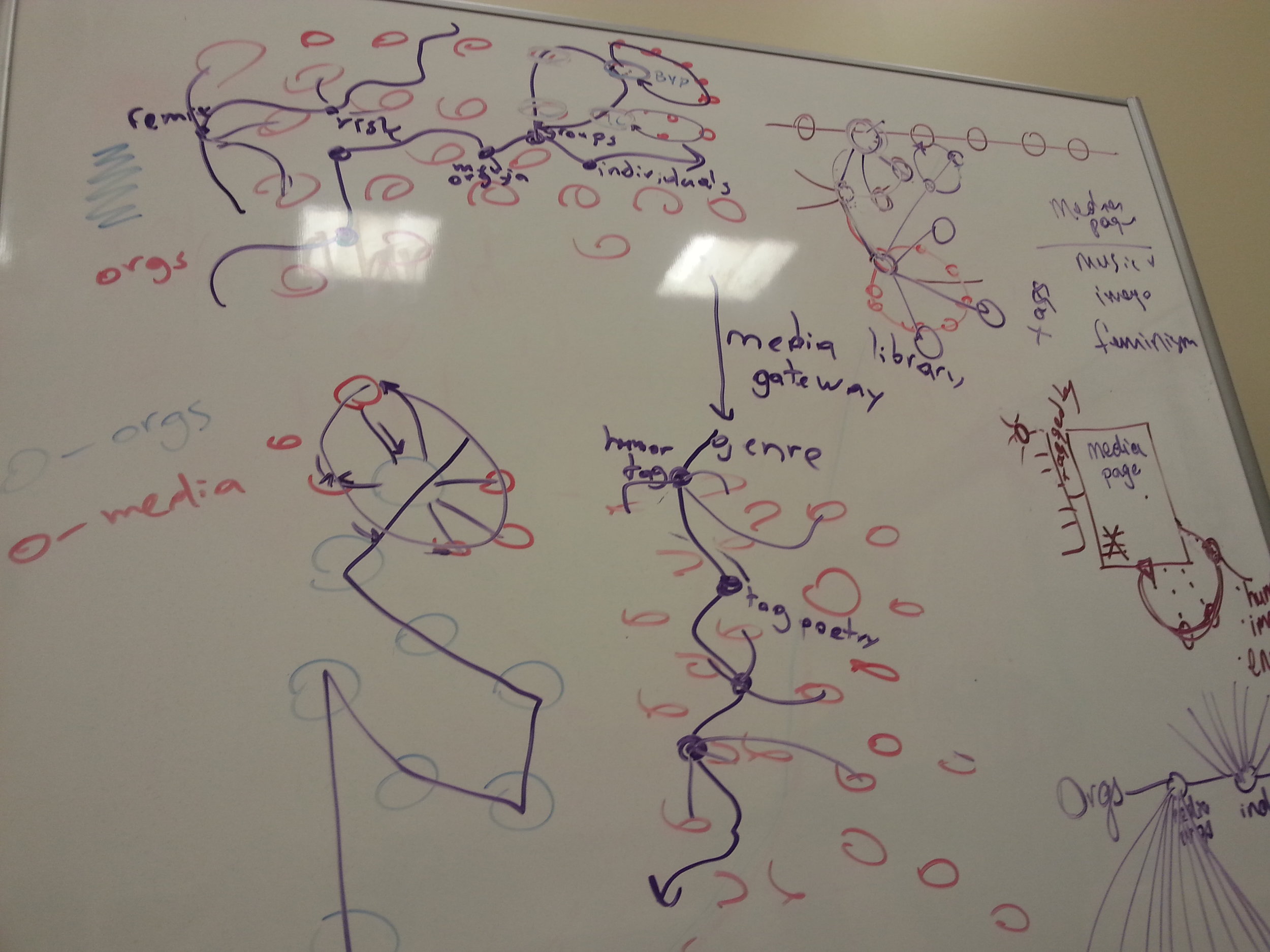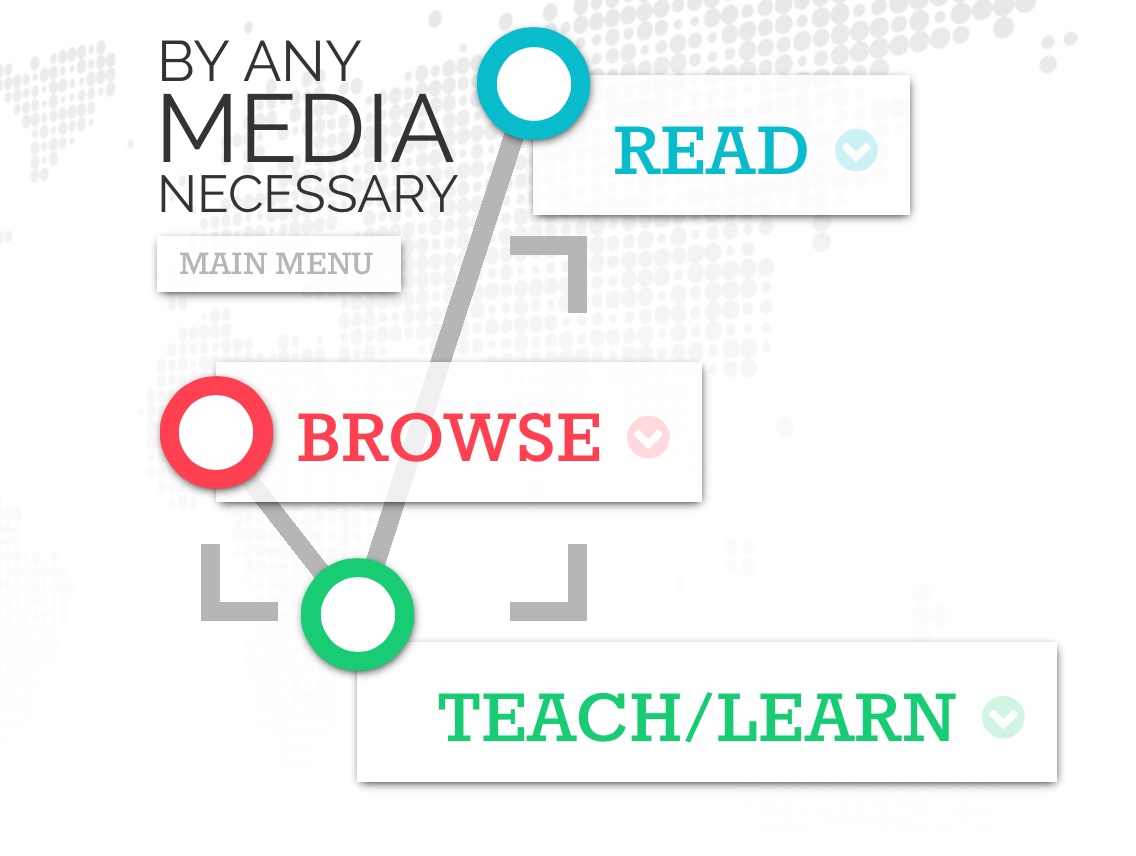By Any Media Necessary (Part Five): By Any Infrastructure
/This is the fifth in a series of posts showcasing the archive and resources we have assembled around our book project, By Any Media Necessary: The New Youth Activism, which is being released by the New York University Press. This book was funded by the MacArthur Foundation's Youth and Participatory Politics Network and written by Henry Jenkins, Sangita Shresthova, Liana Gamber-Thompson, Neta Kligler-Vilenchik, and Arely Zimmerman. By Any Infrastructure Necessary
by Samantha Close
What does a scholarly transmedia project look like? We’ve become familiar with venturing into fictional worlds created by weaving together different mediums, different modes of engagement, and different narratives. For the By Any Media Necessary project, there was already a book being written. When your purpose is to analyze and explain rather than to create and entertain, what kind of digital structure makes sense?
At the start, it looked like a google doc and an excel spreadsheet—the time-honored academic method of listing out sources, citations, key notes, and organizing them into thematic clusters and columns. One of the key affordances of digital media is its ability to extend, to archive more kinds of content in more ways and simply more volume than any one printed book ever could. We used that capacity to accumulate a hefty pile of case studies and examples, interesting groups and fascinating moments, which at that stage of brute force listing and organization could have easily become another book or an article in a journal.
Books and articles are, in general, linear. The argument is organized as a forward march and the existing content materials are marshalled accordingly. What doesn’t fit gets moved around; what doesn’t contribute to the point gets cut. With the digital structure, however, we didn’t have to. Even more than the affordance of abundance, the ability to allow, and even privilege, the winding detour turned out to be key. One argument and line of logic doesn’t need to satisfy all comers because they, like us, can follow and chart idiosyncratic paths through the assembled materials.
After several long meetings, it looked like an alien lifeform. As research assistants, Raffi and I sketched out circles, lines, and arrows in multi-color marker on our meeting room whiteboard, accompanied by snippets of suitably cryptic text.
Our scribblings were motivated by the desire to find a balance between railroading audiences through material without allowing for exploration and dropping them into the middle of a trackless archival heap. The navigational structure had to clarify, not confuse, but also to anticipate a wide range of perspectives. Speaking to different audiences coming from very different places meant that questions like “what items do you put on the main menu?” and “how do you explain that there are educational resources without using the words ‘curriculum’ or ‘education’?” assumed great importance. Using terminology that didn’t signal to the audience who could use the content, that led people to expect something that didn’t follow, or that encouraged people to artificially corral themselves in one small corner of the project could lead to teachers, activists, students, scholars, and other folk closing out and not coming back.
And then, it started to look like a website. A really ugly website. But we were getting there. We settled on a few key navigational principles that balanced separation and classification at the top with a web of dense interconnection once you dove in. Navigating into the archive, you’re asked to choose between learning about people doing things (groups, individuals, and networks) or about the things they were making to do them (different kinds of media). That allowed us to chart out analytical paths through each of these broad categories that highlighted particular properties of activities and texts, like the impact of media form or a focus on a specific issue.
Once audiences drilled down to a particular case, though, they had easy routes out to follow whatever piqued their interest—not necessarily what brought them there in the first place. One could start looking at civic networks, find the Class War Kittehs case and see the way actors within this network join cute (and grumpy) animal memes with strong statements about labor rights and economic policies that they share on social media. Now curious about the use of such memes in activism, it’s easy to move from a focused look at the Class War Kitteh Grumpy Cat (who is still waiting for it to trickle down) to analysis of how single, still images can and are being used to promote social justice. From one of those images, a teacher could move to the Conversation Starter video on remix and authorship, which translates the analysis of how civic networks use images into a classroom-ready prompt for student discussion. An activist passionate about economic issues might move instead from these images to the collection of other organizations tackling these topics with different methods and from multiple points of view.
Writing this now with the advantage of hindsight, the structure seems almost painfully obvious. Of course that’s what we would want! The process of getting here, though, was far from straightforward. It pushed us to conceptualize our material in new ways and to collaborate with both a graphic designer and an interactive media team. For my part, I am almost as excited to see how people engage with the infrastructure as with the content, to the extent that the two even can be separated. Like the activists this project analyzes, we’ve tried to find the best media to get our message across. Come help us figure out where it will go from here!
Samantha Close is a doctoral candidate in Communication at the University of Southern California. Her research interests include digital media, theory-practice, political economy, fan studies, gender, and race. She focuses particularly on labor and transforming models of creative industries and capitalism. Her documentary “I Am Handmade: Crafting in the Age of Computers,” based on her on-going dissertation work into the economic culture of crafting, is hosted online by Vice Media’s Motherboard channel. Her writing appears in the academic journalsFeminist Media Studies, Transformative Works and Cultures, and Anthropology Now as well as in more informal online spaces. You can find her on Twitter @butnocigar.



